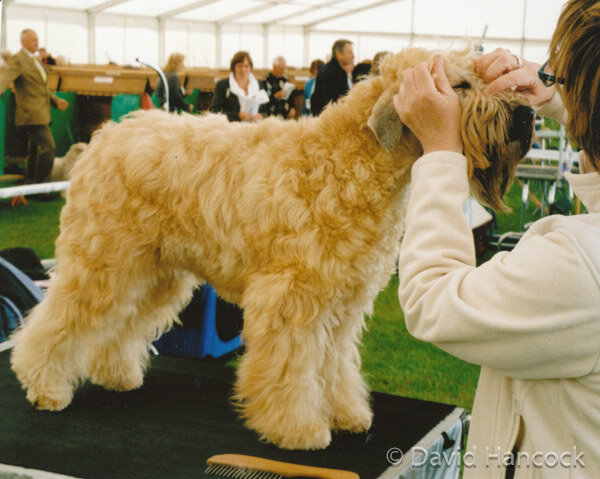1105
TERRIERS' EARS - THEIR 'UPS AND THEIR DOWNS'
By David Hancock
For a working dog, which allows the better hearing - the upright or 'prick' ear or the 'drop' or semi-pendant one? The Mediterranean sighthound breeders have long claimed, to justify the 'bat-ears' favoured in Ibizan Hounds, the Cerneco dell'Etna and Pharaoh Hounds, that such ears enable enhanced hearing to aid prey-detection. The Portuguese Podengo Pequeno is a famed ratter, its prick ears alleged to give it better hearing and therefore quicker reaction times. Herr Dobermann, when developing his pinscher or 'large terrier', went for the drop ear but then the ear-croppers got to work on it! The essential difference between a Norfolk and a Norwich Terrier is in the set of ears, drop for the former, prick for the latter. Smaller breeds like the Corgis and the Laika breeds of north-eastern Europe feature the prick ear, but small hounds usually have drop ears, often of some length. Is it all just breeder fad or does ear-carriage improve performance in a sporting breed? Dog breeds that get involved in combat, however big or small they are, cannot afford to give their quarry something to grab hold of. But the outer ear does provide protection - should an earth-dog just have a neat ear or does its carriage and 'set' actually matter?
The Dandie Dinmont Terrier's standard needs over 140 words to describe the desired ear in the breed; that of the Cairn Terrier only 13. Over 680 Cairns were registered in 2016, under 100 Dandies. Perhaps Dandie breeders have given up trying to produce a 140-word ear! The standard of the terrier-like Affenpinscher, in stark contrast to the Dandie's, is easy for any fancier to aim for: small, set high, either drop or erect. Are the ears of the Affenpinscher less important to their breeders than those of the Dandie to theirs? Of course not, common sense has prevailed. The value of a word-picture lies, not in volume, but in clarity. And for working terrier fanciers, there seems to be clarity; Fell, Patterdale, Border, Sporting Lucas, Plummer and Jack Russell Terriers feature the small, high-set, semi-erect ear - neat, compact and sometimes erect when the dog is interested or alert.
Geneticists tell us much about the inheritance of ear carriage but strangely overlook the clear tendency for long ears in a breed to get longer with each generation. This despite the weight of empirical evidence to demonstrate this fact. The research of Iljin (1937) tells us that semi-erect 'terrier' ears are completely dominant to lop 'hound' and erect ears. Marchlewski (1930) found that the small ear size of the German Shepherd was dominant to the large ear size of the Pointer, and the small triangular ear of the English Pointer dominant over the larger ear of the German Pointer. Pendant ears seem to dominate other ear-carriage types in crosses. Hauck (1949) found that there was no relationship between ear size and the degree of erectness in the ear. But I can find no research on the effect on hearing of the ear's position and carriage. The arguments of the Mediterranean sighthound fanciers that the open prick ear captures sounds more efficiently has some common sense appeal but in northern climes I can see the capture of cold freezing air in the canine ear could be a drawback. The terrier-like Finnish Spitz has to have 'small, cocked, sharply pointed ears, fine in texture and mobile'.
Unusually the ears of the Skye Terrier can be prick or drop but it is not easy to see why the ears of the Bull Terrier should be 'placed close together' or why those of the Bedlington Terrier need to be 'filbert-shaped'. How does this latter breed benefit as a working dog from ears of that shape? Did the working class men who fashioned this breed seek such a feature in their sporting dogs? By what right does the show ring lay down such a feature? Now the ears of this breed have become an attraction for the fashion-groomers; they would have been an attraction too for otters and badgers at one time! But breeders of show ring terriers have rarely respected the function of their chosen breed, that's how unwanted and undesirable exaggerations have gained not just supremacy but consensus - as the Skye Terrier's coat length, the Bull Terrier's head shape and the Soft-coated Wheaten's coat texture demonstrate today. The most popular sporting terrier breed for some years has been the Border Terrier, still like the early dogs and free from fads. On the subject of ears, the Breed Standard of the Border Terrier wastes no words and discourages all faddists: "Small, V-shaped; of moderate thickness, and dropping forward close to the cheek."
When you breed, selectively for coat, as has happened in the Skye, Sealyham, Scottish and Cesky Terriers and now the Soft-coated Wheaten Terrier, you can end up with all coat and no dog. When you breed, selectively, for head-shape, you lose genuine type, as in the Bull Terrier, no matter how widely accepted the new look is. When you breed for 'filbert-shaped ears' you can end up with a faddist's delight - and a sportsman's despair!






